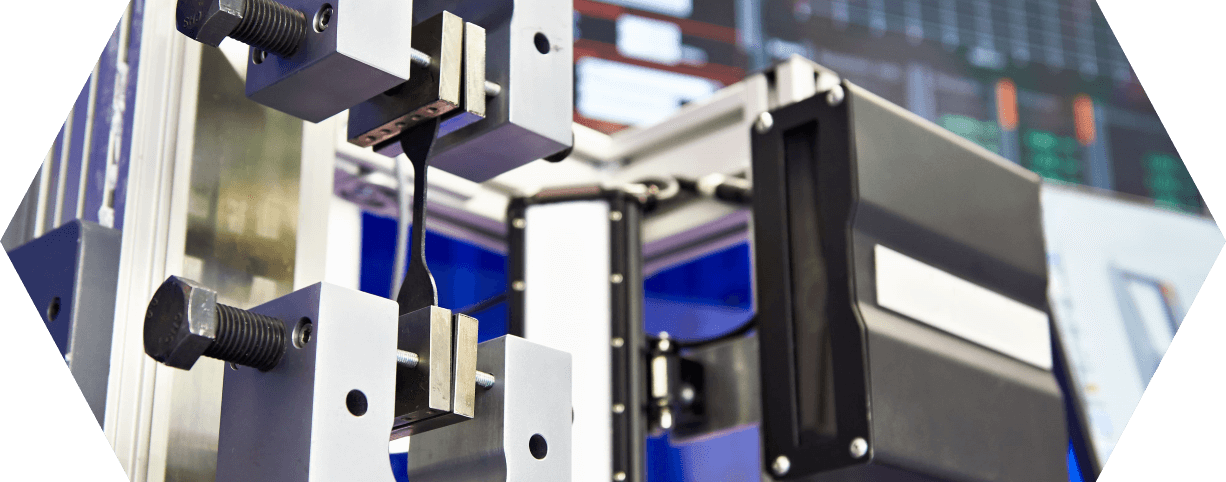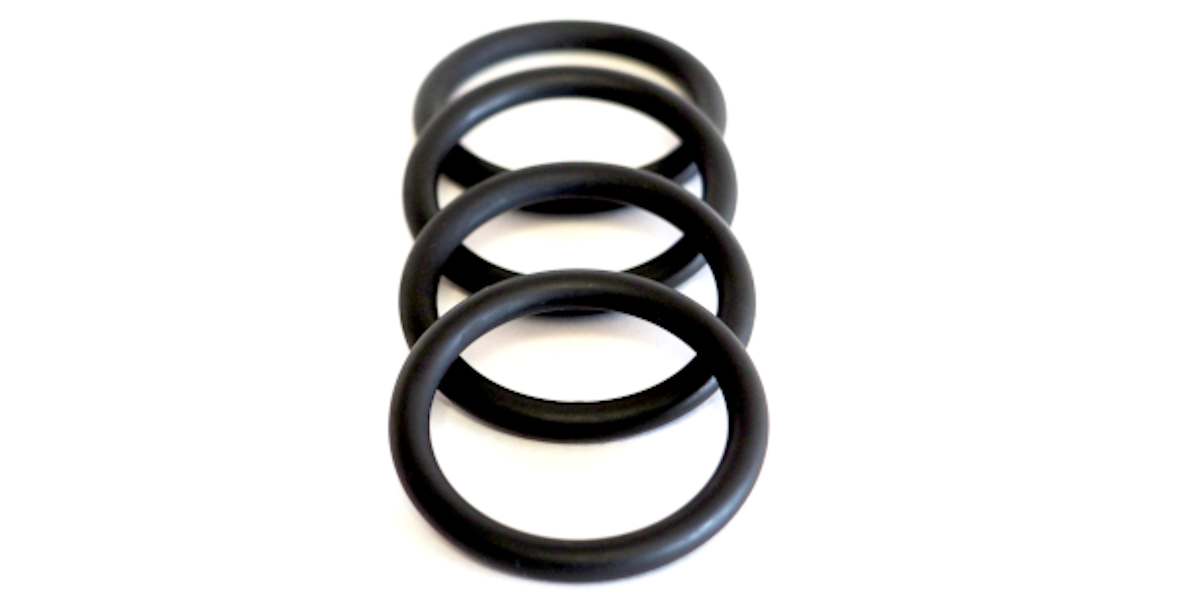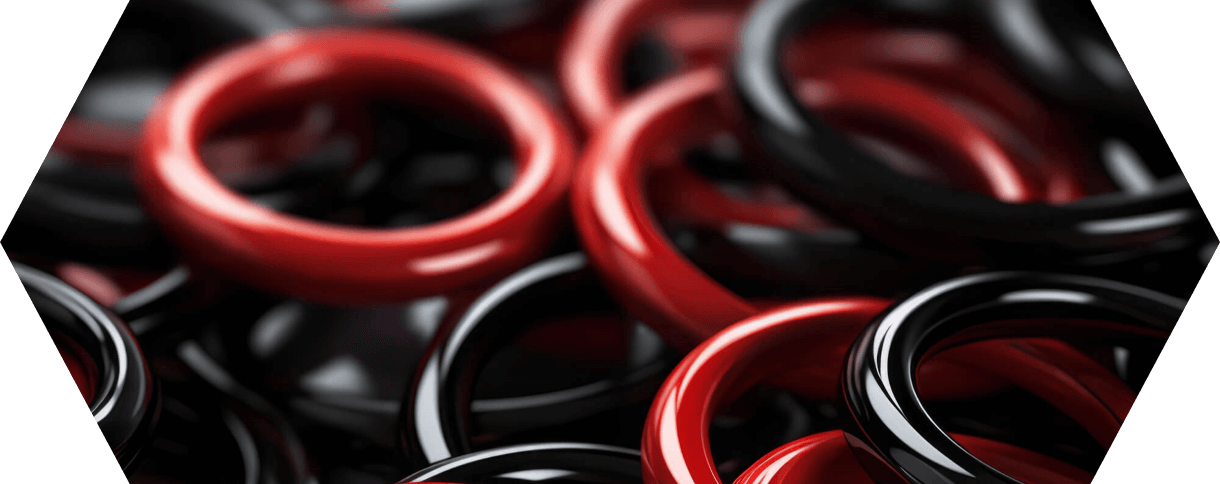
10 questions: O-ring data sheets
In this short article, we answer the 10 most important questions about the correct design of O-ring data sheets in a simple and understandable way.

Friction in contact with harder components causes particles to detach from the surface of O-rings. They therefore lose mass either selectively or over the entire circumference. If this wear mechanism is very pronounced, it can quickly lead to the seal failing.
This is because the lack of material causes leaks. Although it can lead to excessive abrasion, friction cannot be completely ruled out.
This is because it is essential for creating the sealing effect. Only when the pressure conditions press the O-ring against the sealing surfaces can it close small unevennesses in the component surfaces in addition to the sealing gap.
Especially in dynamic applications, abrasion is a major problem for the durability of the seal. However, there are several starting points for reducing mechanical wear. We will also go into this after describing the damage and its causes.
If the O-ring is permanently deformed, it has adapted to a static position in the sealing system. This is determined by the compression of the cross-section between the sealing surfaces.
In addition, a medium such as cooling water or hydraulic oil can exert pressure on the sealing element. This also determines the positioning of the O-ring in the sealing gap and can cause further deformation of its cross-section.
In the case of dynamic sealing, friction is another decisive component. This is the main reason for the damage caused by excessive abrasion.
When analyzing the damage, it is noticeable that the O-ring has lost a significant amount of mass compared to its original condition. As a rule, the cross-sectional area is reduced over the entire circumference.
In this way, abrasion can also be distinguished from permanent deformation. Although the cross-sections take on similar shapes in both cases, the sharp decrease in mass is only evident during abrasion.
Abrasion is caused by the contact of the O-ring with the sealing surfaces, but the effect can be intensified by abrasive particles in the media. The compression required for the sealing effect ensures that the O-ring is in contact with the sealing surfaces.
If it seals a pressurized medium against the atmosphere, this also presses the O-ring against the non-pressurized flank of the groove. This means that friction can also occur on the O-ring when sealing machine parts that are not actually moving.
In dynamic applications, on the other hand, the components regularly move relative to each other. This is the case with pistons and cylinders, for example.
Here the O-ring lies in a groove that is cut into the piston. An oversize of the outer diameter of the O-ring compared to the inner diameter of the cylinder ensures that the O-ring cross-section is compressed. Each time the piston slides up and down in the cylinder, the O-ring rubs against the sealing surface. This generates heat, but also mechanical material removal.
The material removal affects the O-ring, as this is naturally softer than the material from which the cylinder and piston are made. This is the only way he can fulfill his poetic task. This consists of compensating for small manufacturing or wear-related unevenness in the metallic component surfaces. A minimum amount of friction is therefore always necessary to achieve the sealing effect.
Due to their surface properties, elastomers tend to adhere to each other and to machine surfaces. They generally have a high coefficient of friction. If very heavy abrasion occurs on the O-ring, this is usually due to use as a dynamic seal.
However, a certain amount of material abrasion can already occur during installation. However, this is a clear installation error that can be prevented by appropriate training of the technical staff.
Even seals that do not appear to move at first glance can be subject to abrasion. In this case, the machine parts to be sealed do not perform a regular relative movement to each other. Nevertheless, the O-ring can move over the sealing surfaces. Depending on the surface quality of the sealing surfaces, there will be more or less abrasion.
This is due to changing pressure conditions. They allow the sealing ring to move across the entire width of the groove. A high level of abrasion results primarily from the cyclical sequence of extreme pressure conditions.
This happens despite the short distance that the O-ring travels in the axial direction in the groove.
O-rings as dynamic seals are most frequently affected by excessive abrasion. Here they constantly glide over the running surfaces of the components.
Frictional losses can never be completely avoided, but they do reduce the efficiency of a technical system. This is because part of the energy used is lost through friction and is converted into heat.
Firstly, this can often not be recycled and secondly, it causes localized heating on the O-ring. This is just as undesirable, as the effect of temperature can change the material properties of the O-ring.
For dynamic seals, particular attention must be paid to a high surface quality of the running surfaces of the seal. The smoother they are, the less friction there is. Hard particles in the media are also a problem. For example, small metal shavings in lubricating oil can damage the running surface and in turn cause more friction between it and the seal.
Another cause of increased abrasion may be a lack of lubrication. If the seals run dry, friction and thermal load increase.
If you want to prevent excessive abrasion on the sealing element, you can focus on the material and the installation space. The operating conditions with regard to pressure and system operation, on the other hand, are difficult to influence.
The degree of compression also determines the friction. However, the technician can only reduce these within narrow limits.
EMinimum compression must be maintained so that the O-ring has sufficient reserves for elastic deformation. For dynamic seals in particular, the compression is already at the lower limit in order to keep friction losses to a minimum.
It is more promising to specify higher surface qualities for the running surfaces of the seal. Grinding and polishing or chrome-plating the components are processes that can significantly reduce friction.
A reduction in the coefficient of friction of the O-ring surface is suitable for preventing abrasion. This can be achieved by selecting suitable materials and additional coatings. Manufacturers add fillers and plasticizers to the O-ring materials, which help to determine the friction properties. But even the base polymers differ in their abrasion resistance.
In the case of silicone, for example, this is so low that dynamic use should generally be avoided. The material NBR is just as suitable for food applications as silicone, but is significantly more abrasion-resistant.
The market offers various processes for the surface treatment of elastomers. Reducing the coefficient of friction improves the sliding properties of the O-ring.
This is not only relevant for later use in the sealing system. The fully or partially automated assembly of O-rings also benefits from this. This is because if the seals do not adhere to each other, they can be better separated.
However, we are talking about coatings for dynamic use and not those that primarily serve to facilitate assembly.
Modern coating processes cover O-rings and molded seals with a nano-sized layer of bonded coating. The additional material therefore only has a very minor effect on the material properties of the O-ring. The core materials EPDM, NBR, HNBR or silicone can therefore continue to play to their individual strengths.
However, it should be noted that the coating must be stable against the influences during operation. This includes sterilization with hot steam or contact with acids and alkalis. PTFE or polysiloxane, for example, are used as materials for the bonded coating.
Here too, engineers are required to select coating systems that meet the respective requirements from the wide range of solutions available. You will receive expert support from us.
Because our application experts know the technical possibilities as well as industry-specific requirements. This enables them to identify the most suitable alternative.
“I am convinced that we should share our knowledge with the world. I hope I have been able to answer all your questions. If you have any further questions, please feel free to contact us at any time. We will be happy to help you.”

Lord of the O-rings
Author of the sealing academy

In this short article, we answer the 10 most important questions about the correct design of O-ring data sheets in a simple and understandable way.

In this short article, we answer the 10 most important questions about the correct design of O-ring grooves in a simple and understandable way.

In this short article, we answer the 10 most important questions about the correct storage of O-rings in a simple and understandable way.
You need to load content from reCAPTCHA to submit the form. Please note that doing so will share data with third-party providers.
More Information